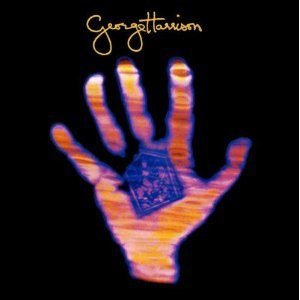Released in 1973, Living in the Material World marked George Harrison’s first studio album after the monumental success of All Things Must Pass (1970). Where All Things Must Pass was a sprawling, ambitious declaration of his post-Beatles identity, infused with Phil Spector’s grandiose Wall of Sound production, Living in the Material World took a more introspective and spiritually focused route. This shift highlighted Harrison’s deepening commitment to his faith, as well as his ongoing exploration of the dichotomy between materialism and spirituality—a recurring theme in his artistry.
The album emerged during a period of seismic shifts in the music landscape. By the early 1970s, the optimism of the 1960s counterculture had given way to disillusionment, and artists were grappling with more personal and existential themes. Harrison, a devout practitioner of Hinduism and devotee of Indian spiritual traditions, stood apart in his steadfast rejection of Western materialism. In many ways, Living in the Material World is a distillation of his worldview, juxtaposing his critique of earthly attachments with his yearning for transcendence.
In interviews, Harrison described the album as an attempt to address his inner conflicts—how to live a spiritual life while navigating the realities of fame and fortune. This tension is not only reflected in the lyrics but also in the music itself, which alternates between lush, contemplative ballads and pointed, biting critiques of material excess. With the departure of Phil Spector as producer, Harrison took a hands-on approach, assembling a tight ensemble of trusted collaborators, including Ringo Starr, Jim Keltner, and Nicky Hopkins. The result is a sound that is both richly textured and more intimate than its predecessor.
Sonic Exploration

The production of Living in the Material World reflects George Harrison’s meticulous attention to detail and his desire for a sound that feels intimate yet polished. After parting ways with Phil Spector’s Wall of Sound techniques that defined All Things Must Pass, Harrison opted for a cleaner and more restrained production style. This choice allows the spiritual gravitas of the album’s themes to shine without being overshadowed by excessive layering. The crispness of the production enhances the album’s meditative atmosphere, with each instrument and vocal line given room to breathe. At the same time, Harrison infused a warmth into the overall mix, creating a sonic palette that feels personal and contemplative.
Musical Arrangements
Harrison’s arrangements on Living in the Material World are deceptively simple, with intricate layering that rewards close listening. The instrumentation is rooted in classic rock, but Harrison incorporates flourishes of Indian music, gospel, and folk, reinforcing the album’s spiritual core. The slide guitar, a signature of Harrison’s post-Beatles work, is prominently featured, weaving expressive and lyrical lines throughout the album.
The rhythm section—anchored by the dynamic duo of Ringo Starr and Jim Keltner—provides a steady yet nuanced backbone, seamlessly transitioning from driving grooves to more subdued, meditative rhythms. Tracks like “Give Me Love (Give Me Peace on Earth)” benefit from these subtle shifts, with understated percussion and acoustic strumming creating an uplifting, prayer-like quality. Meanwhile, orchestral elements, arranged by John Barham, add depth to songs like the title track, where strings and woodwinds underscore the push-and-pull between material concerns and spiritual longing.
Harrison’s vocals, though not technically perfect, carry an emotional sincerity that aligns with the album’s introspective tone. His delivery is often understated, as if inviting listeners into an intimate conversation rather than projecting outward. This vocal approach further enhances the album’s reflective mood, especially on tracks like “Be Here Now” and “The Day the World Gets ‘Round,” where his yearning for peace and transcendence is palpable.
Genre Elements
While firmly rooted in the singer-songwriter tradition of the early 1970s, Living in the Material World deftly incorporates elements of Indian classical music, gospel, and folk rock. The subtle use of tabla, sitar, and other Indian instruments provides continuity with Harrison’s earlier work on songs like “Within You Without You” but is integrated more seamlessly here. The album’s genre-blending feels organic, serving its themes rather than coming across as overtly experimental.
Tracks such as “Sue Me, Sue You Blues” delve into bluesy rock territory, offering a biting commentary on the litigious aftermath of The Beatles’ breakup. In contrast, “The Light That Has Lighted the World” leans into folk-inspired melodies, reflecting Harrison’s penchant for introspection. The title track, “Living in the Material World,” stands out as a fusion of rock and devotional music, with its shifting tempos and layers of instrumentation evoking the album’s central spiritual conflict.
Lyrical Analysis

The central themes of Living in the Material World revolve around the dichotomy between spiritual transcendence and worldly entanglements. George Harrison uses the album to grapple with his role as a spiritual seeker who remains tethered to the material demands of fame, fortune, and personal relationships. This tension is most overtly explored in the title track, where Harrison contrasts his spiritual aspirations with the demands of living in a world driven by materialism.
Harrison’s lyrics also explore broader themes of love, peace, and the human condition. “Give Me Love (Give Me Peace on Earth)” is a plea for spiritual solace and universal harmony, while “The Day the World Gets ‘Round” critiques apathy and encourages collective responsibility. Another recurring motif is the inevitability of change and the transient nature of life, as heard in songs like “Be Here Now,” which urges listeners to embrace mindfulness and live in the present moment.
There’s also a personal edge to Harrison’s lyrics, especially in “Sue Me, Sue You Blues,” which provides a scathing commentary on the legal battles and fractured relationships that emerged during The Beatles’ breakup. Despite the biting tone of this track, the majority of the album carries a message of hope and a yearning for connection with the divine.
Lyrical Depth
The lyrics on Living in the Material World balance straightforward clarity with moments of poetic subtlety. Harrison often employs a direct and conversational tone, especially in tracks like “Give Me Love (Give Me Peace on Earth)” and “The Light That Has Lighted the World,” making his spiritual reflections accessible to a broad audience. However, his writing also contains layers of depth for those willing to engage more deeply.
For example, in “Be Here Now,” the seemingly simple refrain hides a profound spiritual teaching rooted in Eastern philosophy. Lines like “And remember now, be here now / As it’s not like it was before” carry a wisdom that rewards repeated listening and contemplation. Similarly, “The Lord Loves the One (That Loves the Lord)” blends devotional language with an implicit critique of hypocrisy, making its message both universal and pointed.
Emotional Impact
The emotional resonance of Living in the Material World lies in its sincerity and vulnerability. Harrison’s lyrics evoke a spectrum of emotions, from the tranquil hopefulness of “Give Me Love (Give Me Peace on Earth)” to the frustration and disillusionment of “Sue Me, Sue You Blues.” The reflective nature of songs like “The Light That Has Lighted the World” and “Be Here Now” invites listeners to share in Harrison’s spiritual journey, fostering a sense of empathy and introspection.
There’s also a sense of bittersweet beauty that permeates the album. Harrison doesn’t shy away from acknowledging the struggles and imperfections of life, but his lyrics consistently point toward a higher purpose and a belief in the possibility of transformation. This blend of realism and optimism gives the album an enduring emotional power, making it as much a source of comfort as it is a call to action for spiritual awakening.
Cohesion and Flow

Track Progression
The track progression on Living in the Material World is carefully constructed to mirror George Harrison’s spiritual journey, creating an emotional and thematic arc that feels intentional and immersive. The album opens with “Give Me Love (Give Me Peace on Earth),” an uplifting and earnest prayer for spiritual solace, setting the tone for the reflective and aspirational nature of the record. This is followed by tracks like “Sue Me, Sue You Blues” and “The Light That Has Lighted the World,” which introduce contrasting emotions—worldly frustration and serene acceptance—that reflect the album’s central tension between the material and the spiritual.
The sequencing allows each track to complement the next, creating a natural ebb and flow. More contemplative songs like “Be Here Now” and “The Day the World Gets ‘Round” are interspersed with livelier, more direct tracks like the bluesy title track, preventing the album from feeling overly meditative or one-note. By the time the listener reaches “That Is All,” the closing track, the album feels like it has come full circle, concluding on a note of spiritual surrender and resolution. This carefully curated progression gives the album a narrative quality, with each song acting as a chapter in Harrison’s exploration of life’s deeper questions.
Thematic Consistency
One of the album’s greatest strengths is its thematic consistency. From start to finish, Living in the Material World remains deeply rooted in Harrison’s spiritual philosophy and his struggle to reconcile it with the demands of his public life. The recurring juxtaposition of material concerns with spiritual aspirations ties the album together, both lyrically and musically. Even the shifts in tone—from the biting commentary of “Sue Me, Sue You Blues” to the serene introspection of “Be Here Now”—feel purposeful, reflecting the multifaceted nature of Harrison’s experience rather than creating dissonance.
Musically, the album’s cohesion is enhanced by Harrison’s signature slide guitar work, the warm acoustic arrangements, and the subtle yet evocative inclusion of Indian instrumentation. These elements appear throughout the record, creating a sonic thread that binds the tracks together despite their varied moods and tempos. The production style, with its clean, spacious sound, further reinforces the album’s unity, allowing each song to stand on its own while contributing to the larger whole.
Standout Tracks and Moments
https://youtu.be/EjHLxTGn–s?si=szZMBkxAGb6hDEc8
Key Tracks
“Give Me Love (Give Me Peace on Earth)”
As the album’s opening track and one of Harrison’s most enduring songs, “Give Me Love (Give Me Peace on Earth)” is a masterclass in simplicity and sincerity. Its heartfelt plea for spiritual salvation and universal harmony is conveyed through an uplifting melody and a tender vocal performance. The combination of Harrison’s slide guitar and the gentle piano accompaniment creates a luminous, prayer-like quality that resonates deeply, making it an obvious standout both within the album and in Harrison’s solo catalog.
“The Day the World Gets ‘Round”
This poignant track stands out for its reflective tone and moral urgency. A critique of apathy and a call for collective action, the song is anchored by a plaintive melody and understated orchestration that allow its message to take center stage. Harrison’s vocal delivery is particularly moving, imbuing the song with a quiet yet powerful sense of hope and responsibility.
“Living in the Material World”
The title track encapsulates the album’s central theme, juxtaposing lively, blues-infused verses with spiritually contemplative choruses. The song’s shifting tempos and dynamic contrasts reflect the tension between materialism and spirituality, making it a microcosm of the album as a whole. The wry humor of the lyrics, paired with intricate instrumental work, sets this track apart as both thought-provoking and musically engaging.
“Be Here Now”
This meditative piece is a standout for its serene beauty and philosophical depth. Its minimalist arrangement—centered on acoustic guitar and subtle percussion—creates an atmosphere of quiet introspection. The lyrics, inspired by Eastern spiritual teachings, offer a profound reminder to embrace the present moment. The song’s simplicity and earnestness make it one of the album’s most impactful tracks.
Memorable Moments
Slide Guitar in “Give Me Love (Give Me Peace on Earth)”
Harrison’s slide guitar solo in this track is a highlight not only of the song but of the entire album. Its fluid, melodic phrasing captures the essence of the song’s yearning for peace, showcasing Harrison’s unique ability to communicate emotion through his instrument.
Shift in Dynamics in “Living in the Material World”
The transition between the upbeat, almost sarcastic verses and the ethereal, chant-like choruses in the title track is a masterstroke. This shift mirrors the song’s thematic duality and serves as a powerful reminder of Harrison’s skill as both a songwriter and an arranger.
Orchestral Flourishes in “That Is All”
The lush orchestration in the album’s closing track is both subtle and deeply emotive, enhancing the song’s sense of spiritual resolution. The string arrangement provides a sense of finality, bringing the album to a contemplative and satisfying conclusion.
Artistic Contribution and Innovation

Place in Genre/Industry
When Living in the Material World was released in 1973, the music industry was in the midst of a shift. The sprawling, experimental rock of the late 1960s was giving way to the introspective singer-songwriter movement of the early 1970s. In this context, George Harrison’s album stood out for its singular focus on spiritual themes, which were far from mainstream in Western pop music. While artists like Bob Dylan, Joni Mitchell, and Cat Stevens were exploring personal and philosophical ideas, Harrison’s overt integration of Eastern spirituality into his songwriting set him apart as a boundary-pusher.
The album’s commercial success—it reached number one on the Billboard charts—demonstrated that there was an audience for music that transcended conventional pop narratives. Its blend of contemplative lyrics and understated production also marked a departure from the grandiosity of Harrison’s earlier All Things Must Pass, positioning Living in the Material World as a deeply personal work in the artist’s discography. It reinforced Harrison’s reputation as a thoughtful, spiritually driven artist in a music industry that often prioritized commercial appeal over depth.
Innovation
One of the most innovative aspects of Living in the Material World is its thematic ambition. Few albums of its time, particularly within the rock and singer-songwriter genres, addressed spirituality and the human condition with such unwavering focus. Harrison’s ability to weave Eastern philosophies, particularly those of Hinduism, into Western pop structures was groundbreaking, continuing the cross-cultural fusion he had pioneered with The Beatles’ “Within You Without You” and “The Inner Light.” The subtle integration of Indian instrumentation, such as tabla and sitar, alongside traditional rock arrangements, further demonstrated his skill at balancing cultural elements without alienating his audience.
Harrison’s slide guitar work on the album is another innovative feature. By this point, he had refined his slide technique into a signature sound, characterized by its lyrical quality and emotional depth. On tracks like “Give Me Love (Give Me Peace on Earth)” and “The Day the World Gets ‘Round,” the slide guitar transcends its role as an accompaniment, becoming a key narrative voice that conveys emotion as effectively as the lyrics.
Production
From a production standpoint, Harrison’s decision to step away from Phil Spector’s Wall of Sound approach allowed him to craft a more intimate and nuanced sonic landscape. This shift was innovative in its restraint, emphasizing clarity and warmth over spectacle. By doing so, Harrison demonstrated that production could be used not only to enhance the music but also to align it more closely with the artist’s thematic vision.
Themes
Thematically, Living in the Material World broke new ground by directly addressing the struggles of living a spiritual life in a materialistic world. This introspection, combined with Harrison’s willingness to critique societal and personal failings, added a layer of depth that was rare in popular music at the time. The album’s ability to marry this spiritual journey with universal emotions and relatable struggles solidified its lasting impact, influencing both his contemporaries and future generations of artists.
Closing Thoughts

Living in the Material World is a deeply personal and thematically cohesive album that captures George Harrison at a pivotal moment in his career. Its strengths lie in its sincerity, spiritual depth, and meticulous craftsmanship. Harrison’s ability to balance introspection with universal themes ensures the album resonates on both an emotional and intellectual level. Tracks like “Give Me Love (Give Me Peace on Earth)” and “Be Here Now” embody timeless messages of peace and mindfulness, while the title track and “The Day the World Gets ‘Round” offer biting social critiques and calls to action.
From a musical perspective, the album showcases Harrison’s mastery of blending genres, seamlessly incorporating Indian instrumentation, folk, blues, and rock into a sound that feels uniquely his own. His slide guitar work, understated yet expressive vocals, and thoughtful arrangements contribute to an atmosphere that is both intimate and expansive. The production, while more restrained than All Things Must Pass, serves the album’s themes beautifully, creating a soundscape that mirrors the dualities Harrison seeks to explore.
Strengths and Weaknesses
One of the album’s greatest strengths is its thematic consistency. Harrison’s exploration of the tension between materialism and spirituality feels authentic and deeply rooted in his personal journey. The musical arrangements are equally strong, with subtle yet impactful choices that enhance the album’s emotional resonance. However, for some listeners, the album’s focus on spirituality and its slower, contemplative pace may feel less immediately engaging than Harrison’s earlier, more exuberant work. Tracks like “Sue Me, Sue You Blues” provide some variety, but the album largely maintains a reflective tone that might not appeal to everyone.
Official Rating
As a follow-up to the monumental All Things Must Pass, Living in the Material World successfully reaffirms Harrison’s artistic identity while offering a more intimate and focused perspective. It may not possess the grandiosity of its predecessor, but its depth, sincerity, and spiritual conviction make it a standout work in his discography and in the broader landscape of 1970s rock.
This album earns a 10/10 not because it is flawless in a conventional sense, but because it achieves exactly what it sets out to do. Harrison’s artistic vision is uncompromising, and his ability to translate his spiritual quest into music that is both profound and accessible is a rare achievement. For listeners willing to immerse themselves in its reflective world, Living in the Material World offers not just songs but a journey—a timeless meditation on the struggles and joys of being human. It stands as a testament to Harrison’s unique voice and his enduring impact as both an artist and a seeker.
